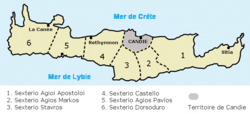Kingdom of Candia
| Kingdom of Candia | ||||||||||
| Regno di Candia | ||||||||||
|
||||||||||
|
The Venetian sestieri of Crete in the 13th century: 1. Santi Apostoli (Holy Apostles), 2. San Marco (St Mark), 3. Santa Croce (Holy Cross), 4. Castello, 5. San Polo (St Paul), 6. Dorsoduro
|
||||||||||
| Capital | Candia | |||||||||
| Religion |
Roman Catholicism (official) Greek Orthodoxy (popular) |
|||||||||
| Government | Colony | |||||||||
| Duke of Candia | ||||||||||
| • | 1212–1216 | Giacomo Tiepolo (first) | ||||||||
| • | 1667 | Girolamo Battagia (last) | ||||||||
| Historical era | Middle Ages | |||||||||
| • | Fourth Crusade | 1204 | ||||||||
| • | Cession to Venice | 1205 | ||||||||
| • | Revolt of St. Titus | August 1363 – 1368 | ||||||||
| • | Ottoman conquest of Cyprus |
1571 |
||||||||
| • | Ottoman conquest of Crete |
1669 | ||||||||
| • | Ottoman conquest of offshore Cretan isles |
1715 |
||||||||
| Currency | Venetian coins | |||||||||
|
||||||||||
| Today part of |
|
|||||||||

Flag of the Republic of Venice
The Kingdom of Candia (Italian: Regno di Candia) or Duchy of Candia (Italian: Ducato di Candia) was the official name of Crete during the island's period as an overseas colony of the Republic of Venice, from the initial Venetian conquest in 1205–1212 to its fall to the Ottoman Empire during the Cretan War (1645–1669). The island was at the time and up to the early modern era commonly known as Candia after its capital, Candia or Chandax (modern Heraklion). In modern Greek historiography, the period is known as the Venetocracy (Greek: Βενετοκρατία, Venetokratia or Ενετοκρατία, Enetokratia).
The island of Crete had formed part of the Byzantine Empire until 1204, when the Fourth Crusade dissolved the empire and divided its territories amongst the crusader leaders (see Frankokratia). Crete was initially allotted to Boniface of Montferrat, but, unable to enforce his control over the island, he soon sold his rights to Venice. Venetian troops first occupied the island in 1205, but it took until 1212 for it to be secured, especially against the opposition of Venice's rival Genoa. Thereafter, the new colony took shape: the island was divided into six provinces (sestieri) named after the divisions of the city of Venice itself, while the capital Candia was directly subjected to the Commune Veneciarum. The islands of Tinos and Cythera, also under Venetian control, came under the kingdom's purview. In the early 14th century, this division was replaced by four provinces, almost identical to the four modern prefectures.
...
Wikipedia


